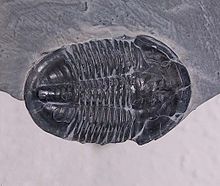

| Wheeler Shale | |
|---|---|
| Stratigraphic range: Middle Cambrian ~507 Ma ↓ | |

Elrathia kingii, famed trilobite of the Wheeler Shale.
| |
| Type | Geological formation |
| Thickness | 100–200 m (330–660 ft) |
| Lithology | |
| Primary | Calcareous shale |
| Other | Mudstone, shaley limestone and limestone |
| Location | |
| Coordinates | 39°15′N 113°20′W / 39.25°N 113.33°W / 39.25; -113.33 |
| Region | House Range and Drum Mountains, Millard Co., west Utah |
| Country | United States |
| Type section | |
| Named for | House Amphitheater (Geographic feature and type locality) |
| Named by | Charles Doolittle Walcott |
| Part of a series on |
| The Cambrian explosion |
|---|
 |
|
Fossil localities |
|
Key organisms |
|
Evolutionary concepts
|
|
|
The Wheeler Shale (named by Charles Walcott) is a Cambrian (c. 507 Ma) fossil locality world-famous[1] for prolific agnostid and Elrathia kingii trilobite remains (even though many areas are barren of fossils)[2] and represents a Konzentrat-Lagerstätte. Varied soft bodied organisms are locally preserved, a fauna (including Naraoia, Wiwaxia and Hallucigenia) and preservation style (carbonaceous film) normally associated with the more famous Burgess Shale.[3] As such, the Wheeler Shale also represents a Konservat-Lagerstätten.[4]
Together with the Marjum Formation and lower Weeks Formation, the Wheeler Shale forms 490 to 610 m (1,610 to 2,000 ft) of limestone and shale exposed in one of the thickest, most fossiliferous and best exposed sequences of Middle Cambrian rocks in North America.[5]
At the type locality of Wheeler Amphitheater, House Range, Millard County, western Utah, the Wheeler Shale consists of a heterogeneous succession of highly calcareous shale, shaley limestone, mudstone and thin, flaggy limestone.[6] The Wheeler Formation (although the Marjum & Weeks Formations are missing) extends into the Drum Mountains, northwest of the House Range where similar fossils and preservation are found.[6]


Detailed work recognises a number of ~10 m thick lagerstätten sequences in the formation, each of which formed at a sea-level high stand[7] in deep water.[8] The lagerstätte were deposited by turbidities and mudslides onto an oxygenated sea floor.[7] The productive layers comprise mud and clay particles, with a tiny fraction of wind-blown quartz.[9]
The Wheeler Shale spans the Ptychagnostus atavus[10] and uppermost-Middle Cambrian Bolaspidella trilobite zones (See House Range for full stratigraphy).

Incomplete list of the fauna of the Wheeler Shale:[6][11][12][13][14][15][16] (Note: the preservation of hard bodied trilobite remains and soft bodied animals seems to be mutually exclusive within particular horizons.)[4][17]